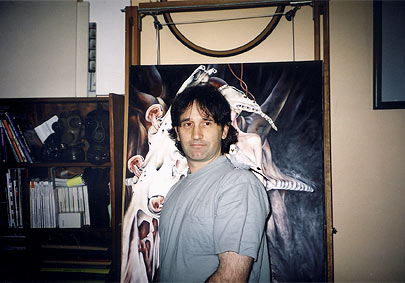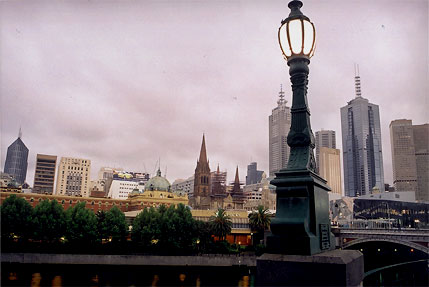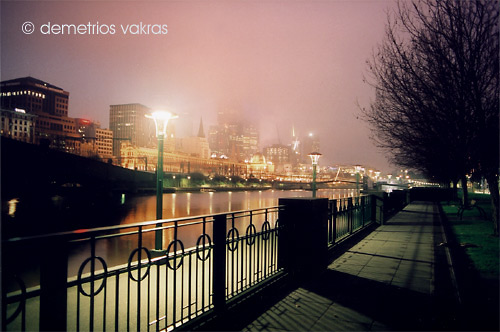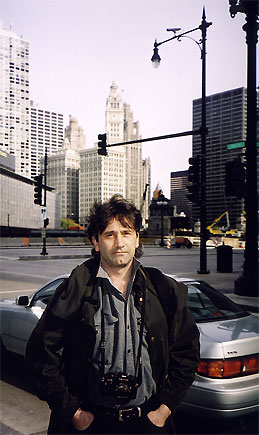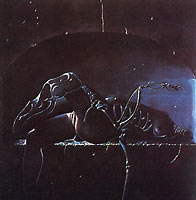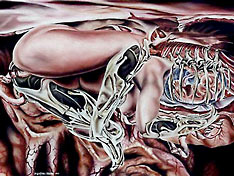|
|
(... the little feathery guy was euthanased by a vet on 28 June 2006. He was suffering from gout - which for budgies is indicative of kidney failure. I have since found that his gout was treatable, however the vet insisted the bird only had one option. It is so quiet now.) |
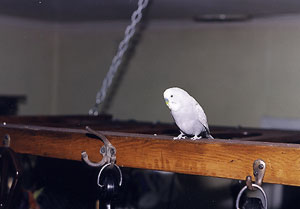 the Hubster .... master of the ambush, the Hubster's idea of a bird bath.... 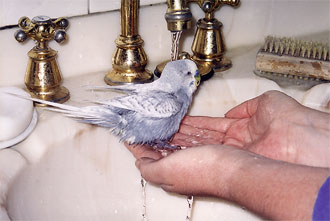 |
Demetrios Vakras was born in Melbourne, Australia, in 1962. He has been painting with oil paints since 1977 and has never wavered from his elucidation of the bizarre, fantastic and surreal. He is self-taught and his earliest influence was the work of the surrealists: Dali, Magritte, Bellmer.
Vakras' current imagery of dismembered human forms recombined with animal skulls, jaw and pelvic bones, stem from his earlier so-called apocalypse series. In these earlier paintings the individual is imprisoned by, and part of, the machinery purpose-created to ease existence, machinery which for the term of an individual's existence requires constant maintenance against its dissolution by entropy.
In his current works the philosophical line has been largely abandoned. Although the pictorial elements remain the same they generally serve no purpose other than the fantastic. Forms metamorphose into unlikely recombinations. He sees veristic illusionist fantastic art as an ongoing theme in western art which includes within its historical repertoire Hieronymous Bosch, Grunewald, Blake, Fuseli, the symbolists, the surrealists, the artists of the Vienna School of Fantastic Realism,...etc.
Illusionist fantastic art predates surrealism. Surrealism is now part of the inheritance of fantastic art to come.
Demetrios lives in Melbourne, Australia.
When the separate colonies of Australia united to became a federation forming the nation of Australia in 1901 Melbourne became its first national capital until 1927.
Canberra has been Australia's capital since 1927.
After the gold rush in the 1850s Melbourne became the largest city in Australia, a position it retained until it was overtaken by Sydney over a century later.
It is now [2002] Australia's second largest city with a population of 3.5 million.
Demetrios' Melbourne-in-fog photographs from the Yarra River.
Melbourne just before sunrise, in fog, August 2004
Melbourne a half hour before sunrise, in fog, August 2004ARTIST STATEMENT:
Although my early art was influenced by the surrealists it has continued to diverge from traditional surrealist principles. I reject the idea that random accidents make for good art (essentially Lautreamont's famed encounter of an umbrella with a sewing machine on an operating table). Unless these accidents are refined and articulated they remain accidents. This therefore takes my work out of the surrealist ambit. My art is closer to what is called fantastic art rather than surrealist. I suspect it would be best described as being closer to a form of 19th century symbolism which however has learnt the lessons of 20th century surrealism - a kind of "surrealised symbolism".
ADDITIONAL INFORMATION:
[ pdf: PDF Flyer on the art of Vakras
pdf in the Greek language: PDF Flyer on the art of Vakras ]
"Man (or woman) it's cold!!"
An autumnal Chicago morning, the temperature hovering at around 3 degrees Celcius (or 38 F), with the wind making it all that much colder, 27 October 2002.
It only gets this cold in Melbourne sometimes, in the middle of winter, in the dead of night!!
But what would the point be of visting anywhere if it was the same as home!
(Demetrios was in Chicago to attend the opening of Echo Gallery's Halloween Exhibition 2002 in which some of his works were featured, along with works by Dan Ouellette, and many others.)
Many artists have had an influence on my own work, from Dalì and Magritte to Bellmer. So too have the works of lesser known artists such as one painting by Pavel Tchelitchev, Cache de cache (hide and seek) 1940-42, and a painting by another artist, Mitsuyoshi Haruguchi (Transmigration of soulsbelow left), which I saw reproduced in the book 20th Century Masters of Erotic Art, Bradley Smith isbn 0-517-542366. The influence of Haruguchi's painting can bee seen in my painting Visceral symbiosis (below right).
Mitsuyoshi Haruguchi, Transmigration of souls, tempera on board. 1978When I added this image, many years ago now, there was no information availbable on this artist on the internet. He now has a website:
Haruguchi, art: http://haruguchi.jp/works_en
(http://haruguchi.jp/index_en)His website provides both a different title and year of creation for this painting: reincarnation - a bird, 1974. (Of course, it could be a different versioin). Haruguchi has an entire series of "reincarnations" of which I was not prevoiously aware (1 Jun, 2009).
Visceral symbiosis, oil, 1993

